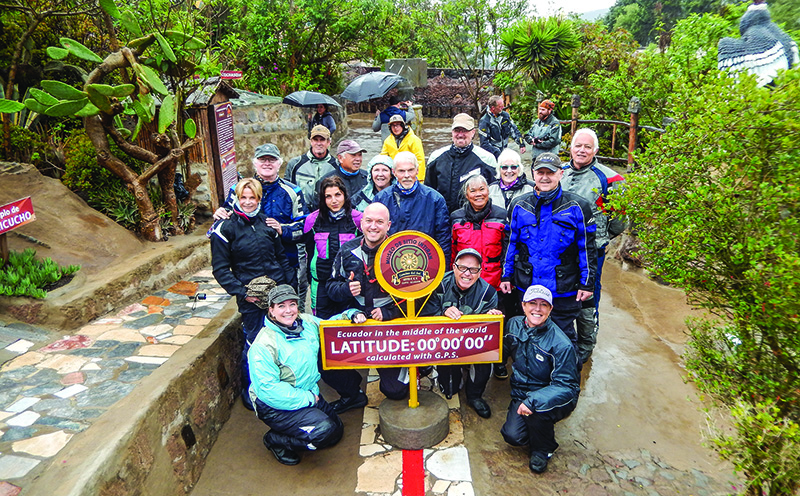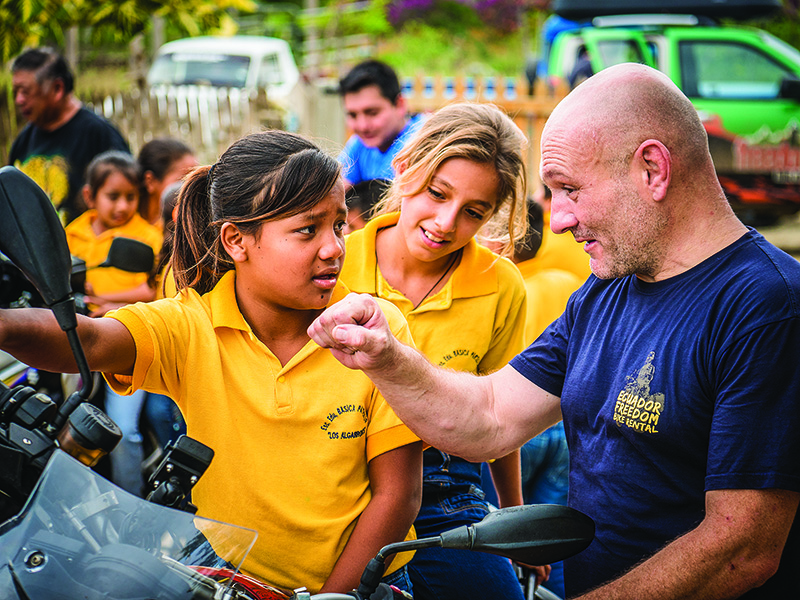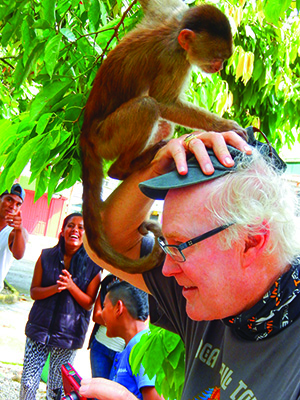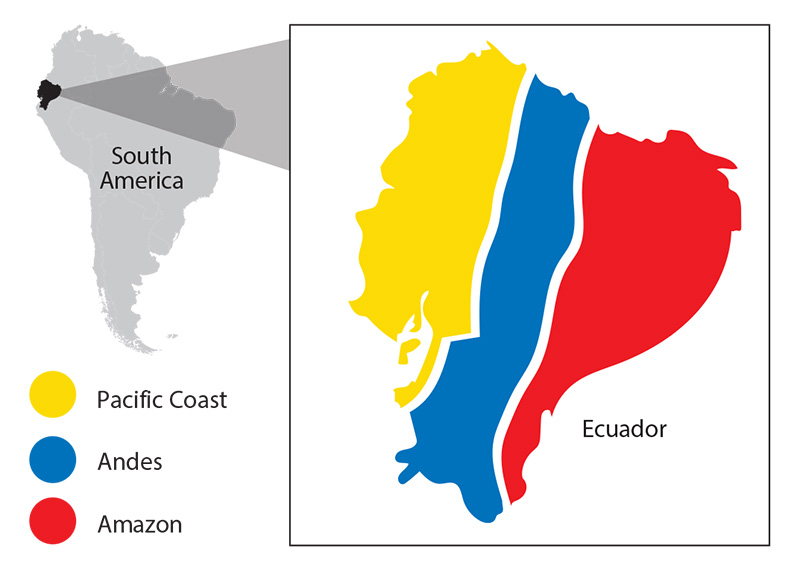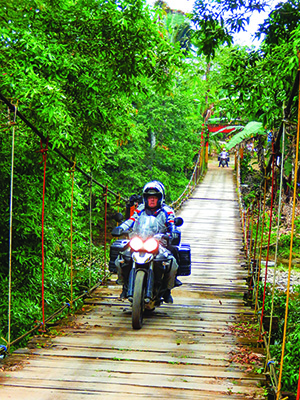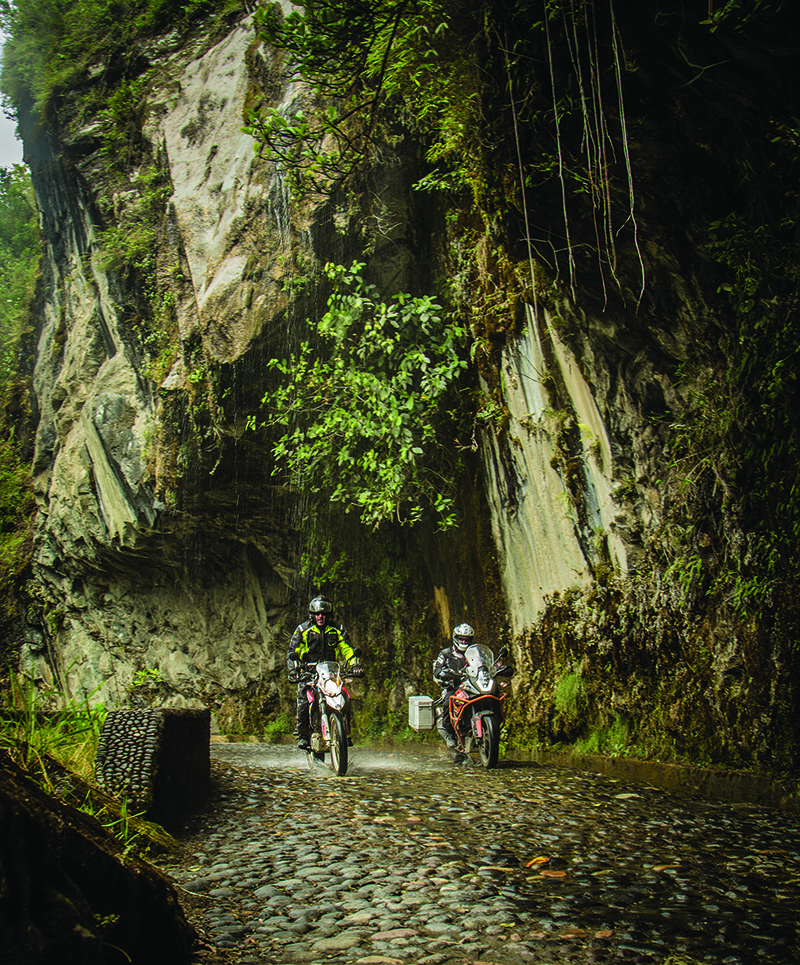
From the hot, humid Amazon rainforest, where we floated down the muddy Rio Arajuno in a motorized canoe and fed sugarcane to monkeys in Puerto Misahuallí, we began ascending the eastern slopes of the Andes. Soon conditions started to deteriorate. First came pelting rain, then came bone-chilling fog and finally our convoy of motorcycles got split in half by a mudslide.
That was before lunch. After we regrouped, warmed ourselves with hot soup and dried out (sort of), we rode even higher, over a 14,000-foot pass where temperatures dropped nearly to freezing. Riding down into the Guayllabamba River valley, the feeling in our fingers began to return and we were soon greeted by the chaotic traffic of Quito, completing our 9-day, 1,100-mile lap around Ecuador.
When considering an overseas motorcycle tour, Europe—particularly the Alps—is a popular choice because the scenery is lovely, the roads are sublime and everything generally runs according to plan. But for those who want a bit more adventure, who want to venture outside their comfort zone, there are less well-traveled parts of the world begging to be explored. Like Ecuador, a small developing country on the northwest coast of South America that packs an incredible amount of cultural, biological and geographical diversity within its borders.
Named after Earth’s bulging, zero-degrees-latitude waistline, which cuts across the northern part of the country and makes weather unpredictable, Ecuador is divided into three major geographic zones, with the Pacific Ocean to the west, the Amazon basin to the east and Andes Mountains down the middle. Experiencing all three is the objective of the Andes, Amazon and Pacific Coast Tour, one of more than a dozen guided and self-guided motorcycle tours offered by Ecuador Freedom Bike Rental, which is based in Quito. Company owners Court Rand and Sylvain Gallea, expats who are fluent in English, Spanish and French and know Ecuador’s back roads better than most natives, lead the guided tours. With 20 people on 13 motorcycles, plus master mechanic Diego Ordoñez and Salina the Wonder Dog in the support truck, our tour group was Ecuador Freedom’s largest ever. Court said most groups are much smaller and tours can be led with as few as one or two riders. Our North American group, ranging in age from 40s to 60s, with six couples two-up and three solo riders, rode an assortment of bikes from Ecuador Freedom’s fleet, including BMWs (G 650 GS, F 700 GS and F 800 GS), KTMs (690 Enduro, 1050 Adventure), Suzukis (V-Strom 650 and 1000), a Triumph Tiger 800XC and a Husqvarna TR650, all of which were outfitted with a tank bag and lockable, hard saddlebags and top trunk.
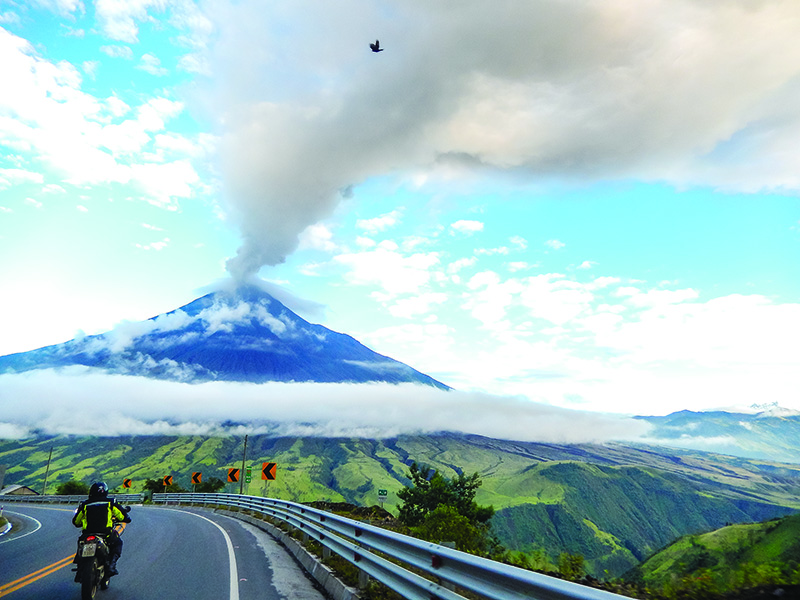
Although Quito isn’t on the itinerary, arriving a day or two early to acclimate to the altitude (at 9,350 feet, it’s the world’s highest capital) and explore the city’s historic center is highly recommended. With cobblestone streets, ornate colonial architecture and cathedrals dating back to the 16th century, Quito earned one of UNESCO ’s first World Heritage Site designations in 1978. My wife, Carrie, and I toured Quito two-up on a small scooter, battling rain, traffic and steep hills that would make San Franscisco jealous.
Our group convened on a cold, drizzly November morning at Ecuador Freedom’s well-appointed headquarters, which includes a lounge, showers, a hot tub, shelves full of gear, rental bikes and a full-service garage. After Court gave us the lowdown on Ecuadorian vehicular regulations (there aren’t many) and ground rules for group riding (we would travel “as a family”), we suited up and hit the road.
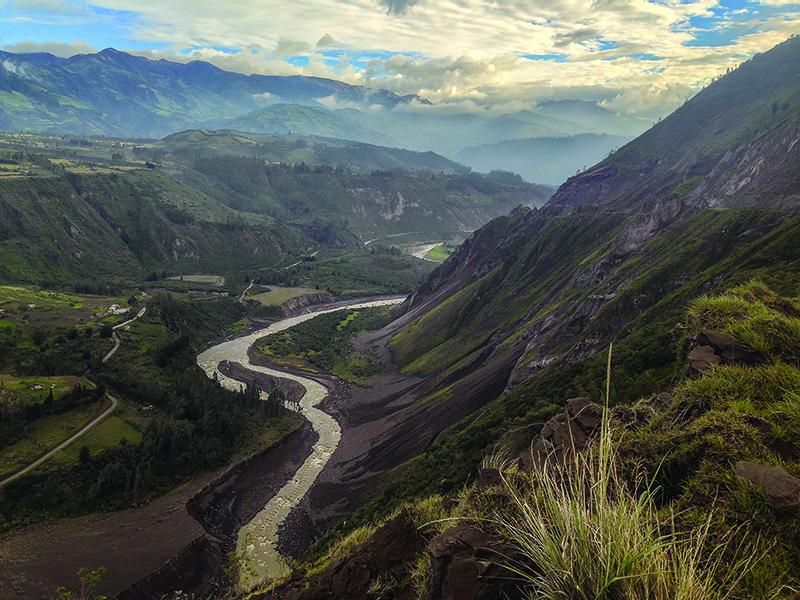
The first day’s riding brought many challenges, from navigating through city traffic in the rain to climbing a wet gravel “ecological route” through a cloud forest to negotiating a steep, unpaved driveway in the dark. This tour is 97-percent paved, which translates to roughly 30 miles off-road over the course of nine days. Pavement in Ecuador is generally of high quality, but reaching some of the best destinations—such as visiting the Bellavista Cloud Forest Reserve to see hummingbirds or spending a night at El Séptimo Paraíso, an eco-lodge hidden in the tropical forest—requires venturing off the tarmac, if only briefly.
With challenges come rewards, like standing on the Equator, with one foot in each hemisphere. Or riding over a swaying, wood-planked suspension bridge. Hiking deep into the jungle to a secluded, waterfall-fed lagoon. Seeing cacao pods grow on trees and how the seeds are transformed into rich, dark chocolate. Delivering school supplies to children (as part of the Pack for a Purpose progam) and sharing in their delight as they sat on our bikes, honking horns and revving engines. And sitting poolside with a margarita, watching the sun sink into the ocean. These fun, unique and uplifting experiences made our adventure that much sweeter.
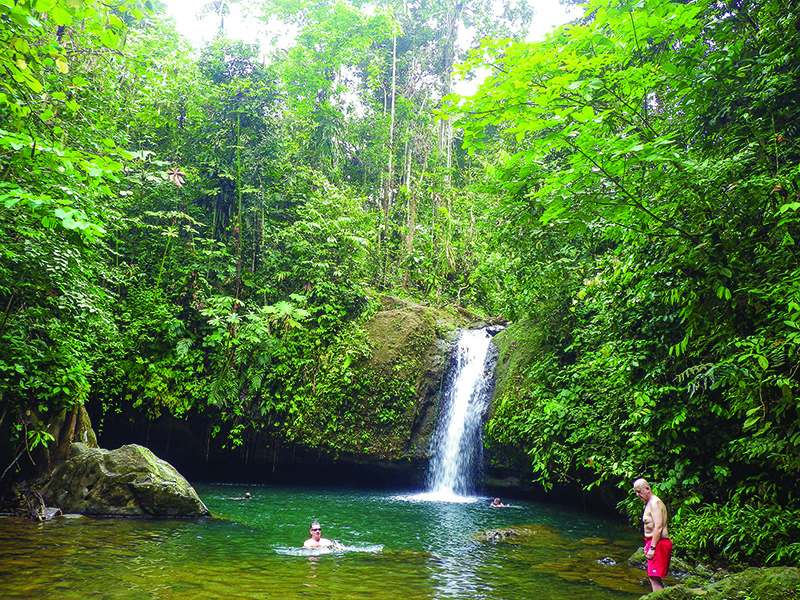
Our route around Ecuador went counterclockwise, northwest from Quito into the cloud forests of Mindo and then due west, down out of the cool, wet Andes and into the hot, dry lowlands of the Pacific coast. After enjoying a leisurely rest day in the beach town of Canoa, we turned inland heading east, where we spent a night on a banana and cacao plantation. Climbing back up into the Andes brought relief from stifling heat as well as the majestic views and tightly coiled, steeply graded roads that motorcyclists crave. There are more than two dozen volcanoes in the Ecuadorian Andes, and we got up close and personal with several. We rode around the base of 20,564-foot Chimborazo (though clouds obscured the peak), stood on the 12,500-foot rim of Quilotoa, a lake-filled caldera formed when a volcano collapsed 800 years ago, and were awed by the rumble of 16,480-foot Tungurahua (“throat of fire” in Quichua) as it spewed ash high into the sky.
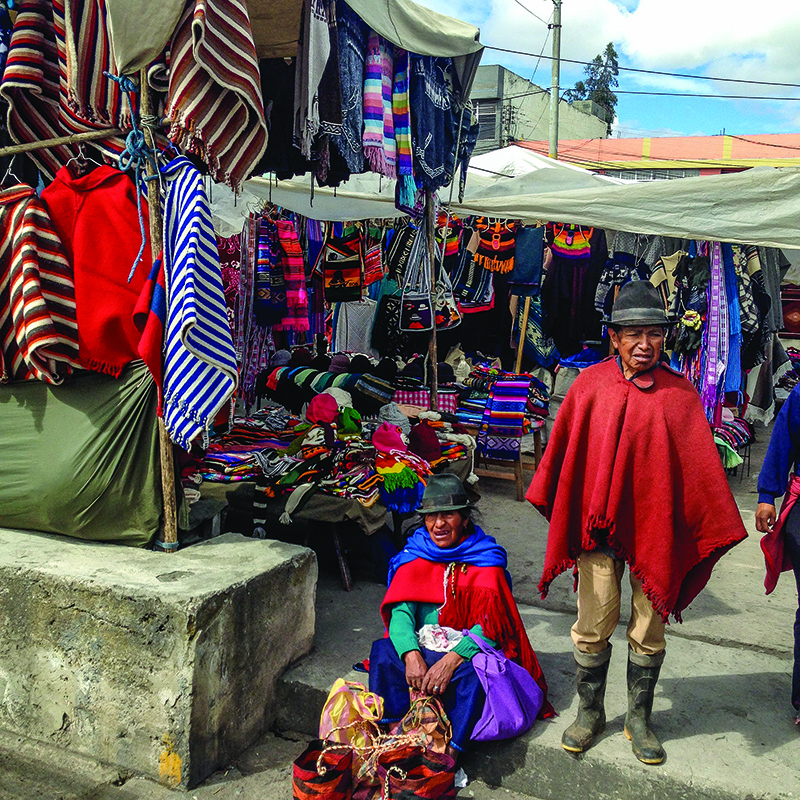
It was a little disconcerting to see Tungurahua’s ash cloud from our hotel in Baños, a scenic mountain town where we spent our second rest day, but the volcano has had a regular case of gas since the late ’90s. After relaxing in Baños, we rode along the edge of the Rio Pastaza canyon, known as the Ruta de las Cascadas (Waterfall Route). Stops along the way allowed us to play like children: swinging from a giant treehouse and ziplining Superman-style over the canyon to the crest of a crashing waterfall on the other side. Riding down the eastern flanks of the Andes, we entered the Amazon basin, where we spent our last night at a riverside eco-lodge accessible only by boat.
Traveling through Ecuador provides constant stimulation for all five senses, as well as for every motorcyclist’s sixth sense, the one that’s attuned to serpentine back roads. For safety’s sake, Court and Sylvain maintained a moderate pace; the roads are not particularly dangerous, but the variable weather conditions, erratic drivers and unpredictable animals—we were chased by several of Ecuador’s ubiquitous “sovereign” dogs and we spooked a few horses, llamas and chickens—call for prudence.
Though it has many wonders and natural riches, Ecuador is a poor country where running water is a luxury for many people. Riding through cities and the countryside, we were confronted with the extremes of poverty, which can be disheartening. We traveled in a large group and stayed at secure, gringo-friendly hotels, so safety was not a concern. But a caravan of more than a dozen big, expensive motorcycles, with riders and passengers wearing state-of-the-art gear and snapping photos with iPads, is an unusual sight in Ecuador. Whenever we stopped, it was as if the circus had come to town. Curious locals, young and old alike, gathered around to ask us where we were from and where we were headed. Following Court’s advice, I kept a bag of candy in the top trunk and handed it out to kids we met along the way.
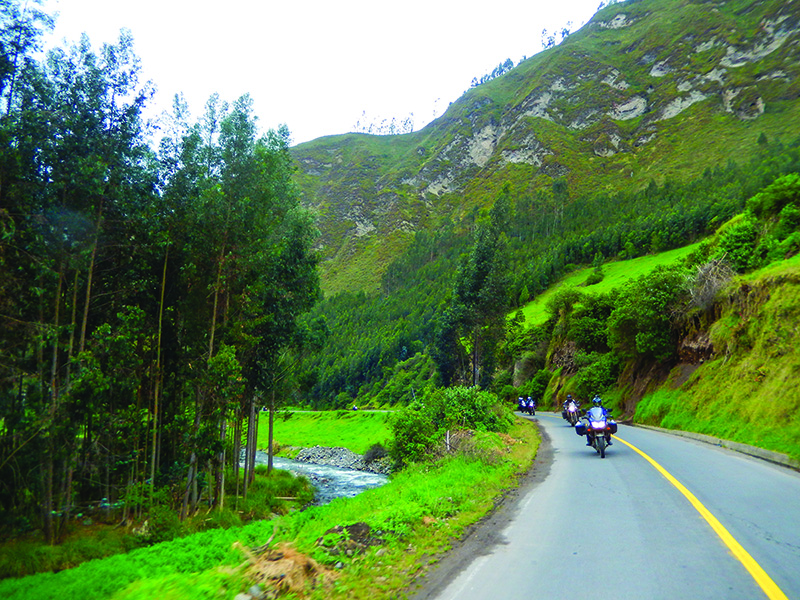
Many Americans have concerns about traveling to less-developed countries, but Court and Sylvain have not had a single security-related incident in their six years of operating tours in Ecuador, which is a stable, democratic country that uses the U.S. dollar as its currency. Accommodations are in comfortable 3- and 4-star hotels and all of the restaurants have been vetted. The tour is a veritable bargain, ranging from $4,215 to $5,280 depending on the motorcycle rented (add $2,690 for a passenger), which includes all hotels, meals on riding days, gas, tolls, entry fees for off-bike activities and a souvenir T-shirt. Getting to Ecuador is fairly easy, too, with nonstop flights to Quito from Houston and Miami, and it’s in the same time zone as the eastern U.S.
As someone who enjoys a challenge, this tour was right up my alley. I had fun, made new friends and have vivid memories that will last a lifetime. But it isn’t for everyone. The days are long and the constantly changing conditions—roads, altitude, weather—are demanding. Some off-road riding experience helps, but what you really need is curiosity and an open mind. Ecuador Freedom makes its tours as much about the roads as about the experience, and it delivers on both counts. If you have a thirst for adventure, Court and Sylvain are happy to oblige.
For more info, visit freedombikerental.com
